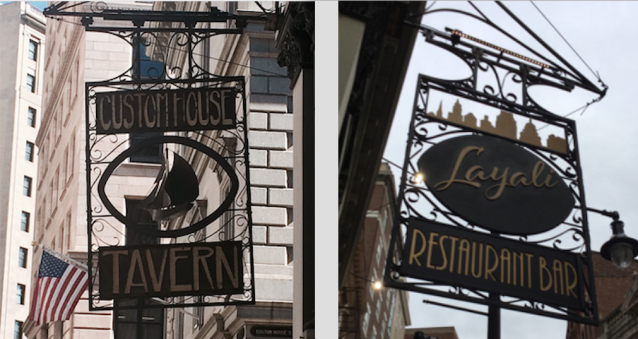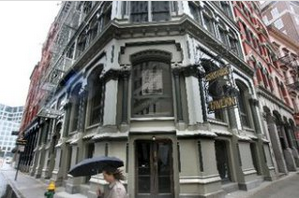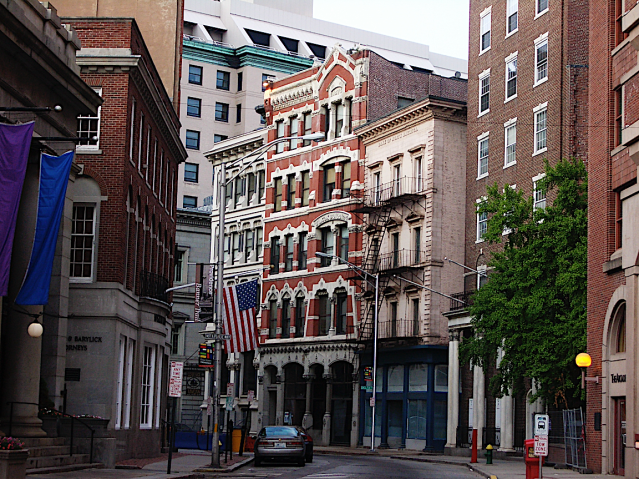
Custom House Tavern sign was renovated for Layali. (photos: GoLocalProv, David Brussat)
My friend Maria Ruggieri and I went walkabout – as Crocodile Dundee would say – in downtown Providence yesterday evening. We popped into a number of new restaurants, the first being Layali, a restaurant/bar (opened by owners of the late Kartabar on Thayer) where the old Custom House Tavern used to be, a step down from the corner of Weybosset and Custom House streets, across from the U.S. Custom House, completed in 1857 and now headquarters of the state judiciary.

Equitable Building, 1872 (OEDaDay)
We sat inside and then moved outside to enjoy the gentle breeze at a sidewalk table. I’d passed by several weeks prior and had noticed with regret that the old tavern’s beloved sign had not been replaced. Last night I discovered that it has now been replaced by the same old sign, pleasantly updated for the new restaurant. The elegant iron filigree remains but the oval that used to encircle the cutout of a ship in full sail is now filled in with “Layali” spelled in fine script. Below the oval, the rectangular panel that once read “Tavern” now reads “Restaurant Bar,” and the rectangle above the oval that once read “Custom House” is gone, replaced by an open rectangle with cutouts of local architecture – a gabled Colonial house, the steeple of the First Baptist Church, the Industrial Trust (“Superman”) Building, the Fleet Center, the Old State House, City Hall, the dome of the “new” State House, and the Biltmore Hotel.
Wow! Very nice! The new sign certainly fills the shoes of the old sign, a landmark of the old, pre-renaissance downtown.
I used to eat at the Custom House Tavern for lunch often during my years working at the Providence Journal. It is in the Equitable Building, flanked by L-shaped Wilcox Building on either side of it, and then the Bank of North America, 1856, by Thomas Tefft, to the right of that on Weybosset, and the Old Colony Bank Building, 1927, to its right. This is the set of buildings that I first saw after dropping off a shirt at the drycleaner – yes, drycleaner! – in the Arcade back in 1984 on my first visit to Providence for a job interview at the Journal. I fell in love with that streetscape, and to this day feel a thrill to the tips of my toes whenever I see it, whether from the west standing in front of the Arcade or from the east, where Weybosset meets Westminster at the end of the bow that the two streets formed until urban renewal took its western end, at Cathedral Square, away from us in 1964.
The interior decor of the tavern was friendlier in the old days, if I recall, more of the ye olde feel, with lots of wood. Today it’s more contemporary, not a lot to make the heart sing. There was talk around town long ago that the building renovation was delayed because of irregularities in the early phases of the work. But hey! A restaurant is now serving in that space again after a vacation (as Buddy Cianci would put it) of all too many years.

Looking east on Weybosset Street from outside the Arcade. (photo by author)



Do you know of any photos of the inside of the Custom House Tavern from around 1981. I remember the old world feel of the place and it was a frequent stop for the best gin & tonic in Providence.
LikeLike
I moved to Providence in late 1984 and may well have taken photos of the inside of the Tavern. But this was before I had a Mac that offered a photo library. Today my photo library has some 50,000 photos and by the time I made use of the library function, the Tavern had moved on from the old days. If any photos of its inside from, say, 1985, exist in my library, I doubt I could find them. Sorry! And yes, as a consumer of G&Ts, I enjoyed the Tavern’s version of my quaff (sp?) of choice.
LikeLike
Not to be lost in our collective memory of an urban walkabout legacy is Lawrence Halprin’s RSVP Cycles from the late 1960s and early 70s. While not totally successful in adapting a written score for experiencing Place derived from wife Anna Halprin’s choreographic notation, his experiential scores for his Take Part Workshops with Journalist partner Jim Burns still exists as a very useful tool for those wanting to follow an experiential approach to planning successful places for and with people. See Landscape Journal. vol :1 no’s 1&2 2012, Judith Wasserman , editor or Jim Burns’s article in Joirnal of Architectural Education vol 31 Spring 1978.
LikeLike
For a Wallabout story see the film:
“Survival in the Outback is the goal for a trio kids in Nicolas Roeg’s “Walkabout”
ByWayne Kleinon January 28, 2012
Nicolas Roeg’s second film (and his first as a solo director)”Walkabout” a pair of children (Jenny Agutter and Luc Roeg)are forced to survive in the Australian outback when their clinically depressed father tries to murder them and, failing to do so, kills himself. The children encounter an Aborigine on Walkabout who ends up befriending them and helping them to survive.“
LikeLike
I’m not even really sure, Ron, that I’d be interested in a walkabout in the real outback. But what a great word! Walkabout! I wonder if it’s really of Aussie origin, or maybe Aboriginal origin. I know, as a dedicated flaneur, that the phrase “walk about” has been used for centuries to describe peregrination through the city. So who was the first to put them together? It’s probably impossible to know for sure, though we can probably track down its first usage in literature. I wonder if it is even listed in the OED as a noun. Hmm.
LikeLike
Dear Ron, sometimes on our walkabouts we have encountered beings that resemble humans does that count?
LikeLike
They ARE the purpose of a Walkabout!
LikeLike
Take a look at my book: http://www.chromatichomes.com
LikeLike
A splash of color here or there is a wonderful thing, John, but too much color can be intimidating, and destructive to the unity in much good architecture. The painted ladies in SF are fine, but let’s not go overboard!
LikeLike
Loved the column! Wow! Two restaurants in one
Day! In your next life you should be a culinary critic!
You should visit the kitchen next time and report
On the food!
LikeLike
Maybe in my next life. Though I’d hate to take such a pleasure as eating and turn it into work. I don’t know how Gail does it!
LikeLike
YES! A great location on possibly the best concave street curve anywhere in the area-shame about the convex side, but maybe Fane will fill the hole behind the bank facade with an 800 foot modern tower to balance the beauty with a beast. Will have to check out Layali.
LikeLike
The convex side is great too, just as great, in part because of the bank facade. It is somewhat harder to view as a set of buildings, but the buildings are equally fine. The Arcade, the law office, the surviving bank facade, the Turk’s Head – what’s not to love!
LikeLike